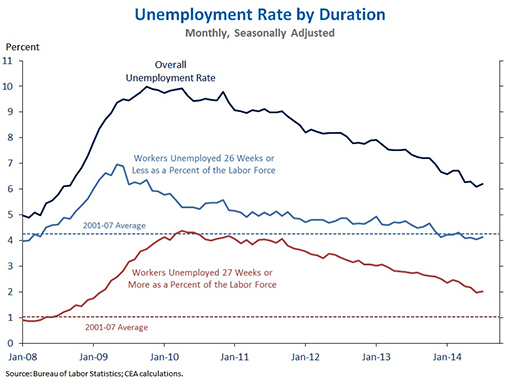
The recent labor market data have been encouraging. Businesses have now added nearly 10 million jobs over 53 straight months of job growth, the longest streak on record. Total job gains have exceeded 200,000 in each of the last six months, the first time that has happened since 1997. And the unemployment rate has fallen rapidly since mid-2013 to reach 6.2 percent in July, 1.1 percentage point less than a year ago.
Of particular note, much of the decline in the unemployment rate has come as a result of declines in long-term unemployment. In fact, falling long-term unemployment accounts for more than 60 percent of the drop in the overall unemployment rate in the last 12 months. This is a disproportionately large share given that one-third of the jobless are long-term unemployed.
The long-term unemployment rate has been cut by more than half from a peak of 4.4 percent in April 2010 — the highest ever recorded — to 2.0 percent in July 2014. Of that 2.4 percentage point decline, 0.7 percentage point has happened since last July, an even larger decline than seen with the short-term unemployment rate. Nevertheless, because the long-term unemployment rate more than quadrupled as a result of the recession, the declines seen recently are still not yet sufficient to return long-term unemployment to pre-recession levels.
The fact that long-term unemployment continues to improve along with other areas of the economy supports the view that long-term unemployment is a challenge but one that we can address. Research has shown that that the long-term unemployed are in many ways quite similar to those who have been unemployed for shorter durations, except for the fact that their initial bad luck has become a terrible extended hardship, in some cases because prospective employers are hesitant to give them another chance.
Crucially, the recent decline in long-term unemployment has coincided with a stabilization in the labor force participation rate, suggesting that many formerly long-term unemployed are finding their way back to work. Indeed, job finding rates and the ability to find stable employment among the long-term unemployed have improved in the first half of 2014.
The Administration has also taken steps to help more of the long-term unemployed get back to work. Earlier this year, the President unveiled a set of “best practices” being taken by leading employers — including over 80 members of the Fortune 500 and over 20 members of the Fortune 50 — around recruiting and hiring the long-term unemployed, to remove some of the barriers that make it harder for them to navigate the hiring process.
As follow-up, Deloitte Consulting and the Rockefeller Foundation are working together to create an employer playbook that will help companies implement these best practices — building on progress that companies like Aetna, Metlife, and Frontier Communications have made to improve their recruiting of the long-term unemployed. The Department of Labor will soon be awarding $150 million in “Ready to Work Partnership” grants to support the best models for partnerships between employers, non-profits, and the job training system to help train and connect the long-term unemployed to work.
Progress is being made, but the long-term unemployment challenge is far from solved. The long-term unemployment rate remains roughly double its pre-recession average, and as shown below, accounts for essentially all of the remaining elevation in the overall unemployment rate. In addition, the experience we are coming through with respect to long-term unemployment is unprecedented, and we are still learning the full implications for families that have been affected by this terrible legacy of the Great Recession. As a result, the President will continue to focus on this issue, working to do everything he can to help the economy add jobs, raise wages, and increase economic growth — especially for the long-term unemployed.





